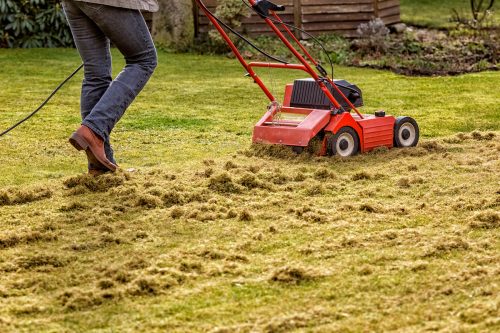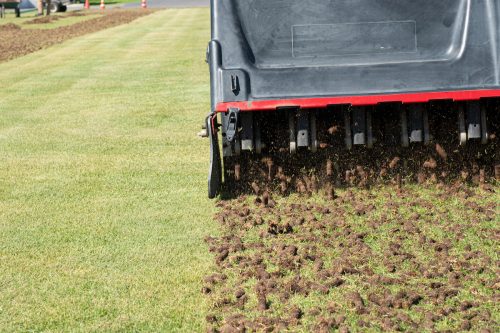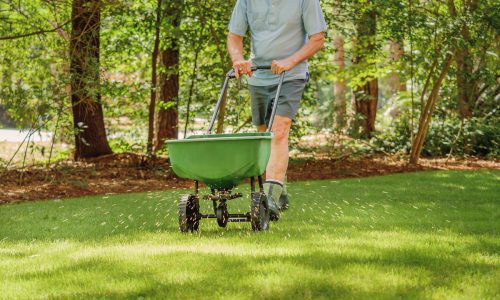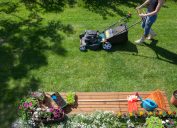Landscaping Influencer Reveals How to Make Your Lawn Thick and Green
The fall is when you'll want to take extra care with your grass, he says.
Spring may be the season where you break out the lawnmower and start tending to your garden, but fall is when you'll want to put in the work to ensure your grass grows back nice and healthy after the colder months. In a TikTok video, Chris Kanan (@ope.itsmowtime), landscaping influencer and host of The Lawn Feed podcast, shares what you need to do with your lawn before winter.
"Do these things and your cool season lawn will thank you later," he notes.
Keep reading for his best tips to make your lawn thick and green.
RELATED: 6 Ways to Make Your Lawn Maintenance-Free.
1
Dethatch your lawn.

Kanan's first tip is dethatching. According to Better Homes & Gardens, thatch is a "matted layer" of grass stems, roots, and other organic material that builds up directly on top of the soil. When this layer gets to be more than a half-inch thick, it can create all sorts of problems, including blocking nutrients, harboring disease-causing insects, and causing roots to grow incorrectly, they explain.
Therefore, dethatching "will remove all of the dead grass debris and organic matter from the surface of the soil, allowing more airflow, moisture, and nutrients down to its roots," explains Kanan.
If your thatch problem is moderate, BHG says a cavex rake (an inexpensive rake you can find at most hardware stores) will probably do the trick.
If it's worse, they recommend using a vertical mower, also known as a power rake, which is what Kanan is seen using in his video.
"Resembling a heavy-duty power mower but with a series of spinning vertical knives, it cuts through thatch," BHG notes.
RELATED: Gardening Influencer Reveals the #1 Plant to Give Your Yard Beautiful Color.
2
Core aerate your lawn.

Oftentimes, dethatching and aerating go hand-in-hand.
"Most lawns are going to be more compacted than they should be," notes Kanan. "The goal of core aeration is to remove the plugs [compacted clumps of soil] from the ground, allowing additional airflow, nutrients, and moisture down into the soil for a thicker root system for years to come."
In a separate video, he shares that a simple way to know if your lawn is compacted is to take a screwdriver and stick it into the ground.
"It should go in just like a butter knife, but on the contrary, if your screwdriver takes a little bit of effort, or a lot of bit of effort, to get in there, it's time to aerate your lawn."
According to Home Depot, there are two tools you can use to do this—plug aerators and spike aerators.
"Plug aerators, also called core aerators, have hollow tines and remove plugs of soil from your lawn," they write. "Spike aerators have rollers with solid spikes that puncture holes in the ground." The latter is usually recommended for smaller lawns.
Kanan then explains that you can either pick up the leftover plugs or leave them, as they'll "provide free nutrients down to the soil."
RELATED: 6 Ways to Pest-Proof Your Grass, According to Landscaping Experts.
3
Fertilize your grass.

Kanan's third fall lawn tip is to fertilize your grass: "Contrary to popular belief, fall is the most critical time to feed your cool-season lawn. It's about to go into hibernation for the long winter and is seeking a big meal before it dozes off for a couple months into dormancy."
In his video, Kanan is using a spreader machine to distribute the fertilizer, but if you don't own one of these, he suggests renting the equipment with a group of neighbors to save money.
RELATED: 5 Clever Ways to Get Your Mums to Last All Fall.
4
Overseed your lawn.

In another series of videos, Kanan shares the benefits of overseeding, or laying new grass seed over your existing lawn. This is something you'll want to consider if you have a lot of dead grass or bald spots.
He says the fall is the best time to overseed because "the new grass seeds won't have to go through a hot, stressful summer, and they get to go do it in ideal growing conditions." Additionally, it allows the grass seed to "germinate with enough time before our first frost and first freeze," he adds.
Keep in mind that there are various types of grass seed, but for a residential lawn, Kanan recommends "tall fescue." He says this grass is low-maintenance and drought-tolerant.
For more lawn and garden tips sent directly to your inbox, sign up for our daily newsletter.






















